
views
Growing out Your Grey Hair

Cover your roots with a headband or hat. Use the headband or hat as your roots start to grow out, and it will hide them so they're not as stark during the transition. Your natural grey may be fairly light against your dark hair. As your hair starts to grow out, your roots are going to show. For instance, try a baseball cap if you like a sporty look or don a wide-brimmed hat if you're going to be outside. Pick a wide headband over a narrow one, as that will hide your roots better. You could also use a head scarf for a fun option. You can wear your scarf as a headband or as a cover for you entire head. Try different knots to add more style to the look.

Skip using a shampoo for color-treated hair if you've dyed it. If you've been covering your hair by dyeing it, you may have switched to a shampoo to protect the color. Now it's time to go back to regular shampoo, which can strip the hair of color and help fade it slowly to the silver-grey underneath. In addition, use a toning shampoo to help define the grey color. If your natural color is a little too yellow/brassy for your liking, a purple shampoo can also help. Just use the toning or purple shampoo in place of your regular one about once a week. Alternatively, try a shampoo specifically for grey or silver hair.

Add hair masks to your routine for hydration. Try a mask aimed at your specific type of hair. For instance, for damaged and dyed hair, pick a restoring mask. For curly hair, opt for an extra hydrating mask. Typically, you apply the mask to your hair and let it sit in your hair for a period before washing it out. Natural grey hair tends to be coarse and dry, which can make your hairdo look dull and lifeless. Masks can add hydration and make your hair healthier and shinier. You can also make your own hair mask at home.
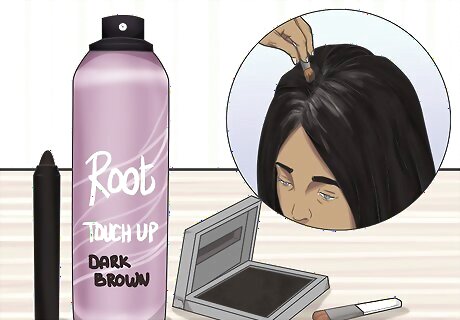
Use coverage sticks, powders, or sprays for temporary root coverup. These concealers help hide your roots, and they're easy to apply. For instance, with a spray, you spray it into your roots, staying about 6 inches (15 cm) from your head. You can find these products at a local beauty store or online. For sticks, you rub it in like a makeup concealer, coloring in the roots from your part outwards. With powders, you may need to apply a pre-treatment first, which will help the powder stick, and then gently brush in the powder, working from your part outward. These are temporary fixes, and they will typically wash out when you shampoo your hair.
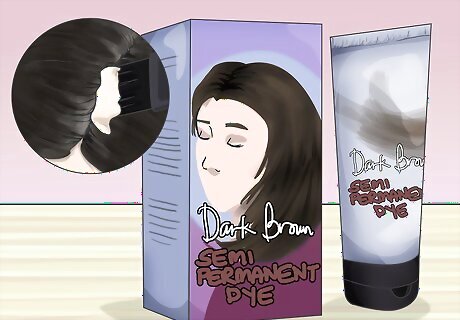
Try a semi-permanent hair dye to hide the roots and slowly fade out. Pick a color that's closer to your natural grey color. Then, as it grows out, the difference won't be so stark. Plus, because the dye is semi-permanent instead of permanent, as the dye washes out, it will fade into the grey area for a smoother transition. For instance, if you have dark brown hair, try going a few shades lighter to help make the transition and cover your roots. Some specialists recommend using demi-permanent hair dye in this instance, since this kind of dye doesn't go too deeply into the hair. Make sure you're not staining the hair too much. If you do, you run the risk of actually washing it out with a stain left behind in the hair.
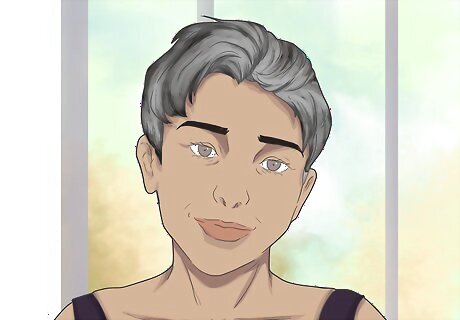
Chop off your hair to a pixie cut if you want to transition quickly. Once your roots grow out, simply cut off everything that's not grey. It's a drastic change, but one that can make the transition easier, since you don't have to live with half grey hair. Ask a stylist to help you figure out the best cut for you.
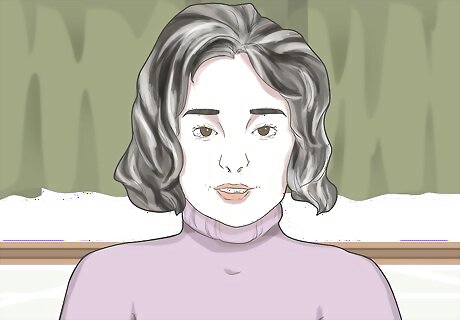
Add salt-and-pepper streaks to your hair for a more subtle change. Another option is to grow out your roots, then create a salt-and-pepper effect with the rest of your hair. The colorist will do this by adding grey streaks into the color you already have. The downside is the colorist basically has to bleach some strands of your hair and add the grey back in. That can be damaging to your hair. If your hair is already damaged, it's not a good idea to bleach it.

Pick a contemporary cut to make your look more modern. If you're worried grey hair will age you, a contemporary cut is a good option. It can make your grey hair seem sleek and modern, rather than aging you. Talk to your hair stylist for options that work with your color and face shape.
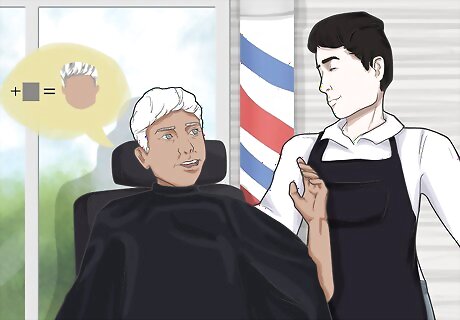
Ask to have grey added to white hair. If your hair is all white, it can lack dimension. Your stylist can add in some grey highlights to give it a more salt-and-pepper look. The stylist can also adjust your grey to your hairstyle, meaning they can put highlights in the best places to accentuate it.
Dyeing Your Hair Grey at Home

Pick a trusted name in bleach and developer. Your drugstore or salon store should have a variety of bleaching agents. Pair one with a 20 volume (peroxide) developer or lower. If you use 40 volume, you can damage your scalp. Avoid bleaching your hair if it's processed, particularly if you used a dye containing metallic salts. It can cause severe damage to your hair. Keep in minding that going from dark hair to light hair causes more damage then bleaching from a lighter color. It can help to hydrate your hair in the weeks before you bleach your hair. Try using conditioning masks several times a week in the 2 weeks before you dye it. The idea is to get all the undertones out of it so you can have a clean background to put the dye on.

Wear rubber gloves when you're handling hair dye. Bleach and dye have chemicals that can damage many surfaces, and you don't really want to let them sit on your hands, either. Wear rubber gloves, and make sure the area is well-ventilated. Also, cover any surfaces with plastic trash bags that you don't want to see damaged. For instance, you may want to lay one down on the counter where you're mixing your dye. Newspapers are also a great way to protect surfaces you don't want damaged by the dye. Simply spread the newspapers over your working area.

Divide your hair into 4 parts and tie it up to begin bleaching it yourself. Part it down the middle, and then divide each side into 2 parts. Tie the hair up with a hair tie, and use the hair tie to hold the long strands in place, so you mostly have exposed roots at this point. Exposing your roots makes it easier to get it on evenly at the top.

Mix bleaching powder with developer in a plastic bowl. Typically, the ratio is 1-to-1. However, it does vary by brand, so read the labels before mixing. Mix it together with a hair dyeing brush, which often comes with hair dyeing kits and bowls. Stir it together until it's completely combined. Be very careful bleaching your hair on your own. If you have pre-processed hair, it can cause severe damage.

Paint the bleach on your hair, starting at the roots. Use the brush to apply the bleach and developer to your hair, going over your exposed roots first. In the back, move up from your neck to the hair you've tied up. Then, let down your hair, and paint the bleach down to your tips. To make sure you're getting it all over your hair, comb out small sections at a time, and apply the bleach to each section. Be careful not to get bleach on your scalp. It can burn your sensitive scalp.

Leave the bleach in for up to an hour before rinsing it out. Check on your hair every 5-10 minutes to monitor the color. Wash out the bleach when your hair reaches the color you want or after an hour, which is the longest it should set. Rinse the bleach out thoroughly, making sure you don't get it in your eyes. Then, wash and dry your hair like normal. Always read the directions first, as some products may advise you to leave it in for less time. You may need to do a second treatment to get your hair light enough. If you do, wait at least a week to give your hair time to recover.

Apply a toner and developer to create the grey tone. A toner works to change the color of lightened hair, and it can turn it from blonde or yellow to grey. Like the bleach, mix the toner with a developer (try 20 volume), and then apply it in the same way you did the bleach.
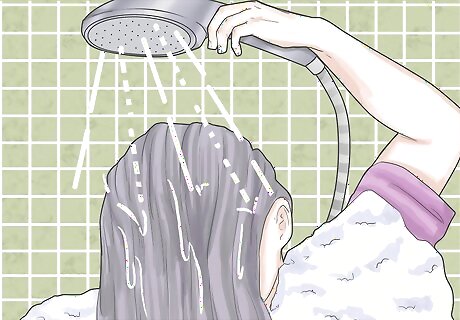
Rinse it out after the package-recommended time period. Read the directions for how long you should leave it in. When you've left it in long enough, rinse it out, then wash and condition your hair as you usually do.
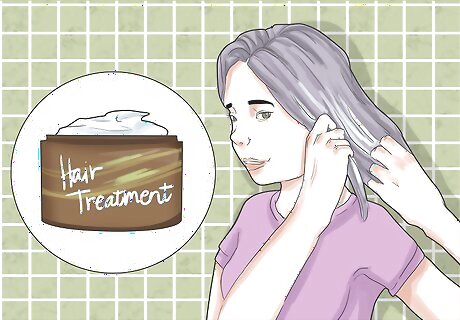
Use moisturizing treatments to repair damaged hair. This process will damage your hair because bleach is damaging. To help get it back to its previous glory, use moisturizing treatments like masks and leave-in conditioners. Opt for a restoring mask. Typically, you leave it in for a little while, then wash it out. You can even make your own by mixing equal parts of argan oil and coconut oil. Warm the oil up a bit, then apply it to your hair. Put a shower cap over your head, then wrap it in a hot, damp towel. Let it sit for 2-3 hours.












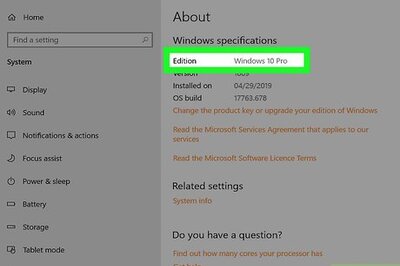
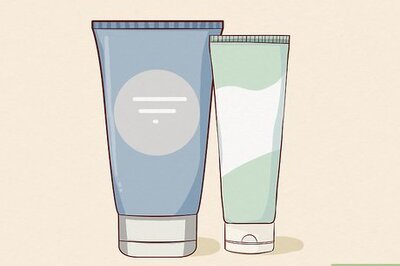





Comments
0 comment